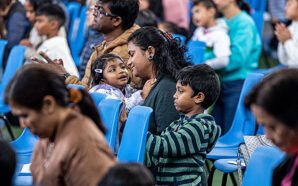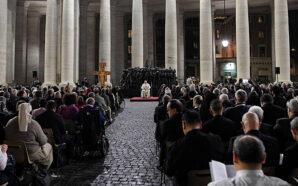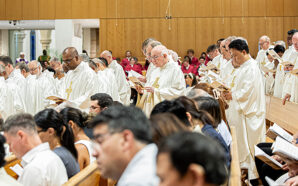Throughout the Second Assembly of the Fifth Plenary Council of the Australian Catholic Church, we learnt from experience that synodality is not for the faint hearted, writes Patty Fawkner SGS.
During the Assembly, which was held in Sydney from July 3-9, the response by Members to the cry of our Indigenous sisters and brothers was uncompromised and magnanimous. The response to the cry of those abused by the Church was heartfelt and generous. The response to the cry of the earth was a forward-looking commitment.
The response to the cry for women to be treated with equal dignity in the Church? This was confused and lukewarm.
What is it about women and the Church?
In previous editions of The Good Oil, I have spoken about women and the Church, and expressed hope that the Fifth Plenary Council would endorse the equal dignity of women and men, and so enhance the role of women in Church leadership and governance.
On the third day of the Assembly, the vote on Part 4 of the Motions and Amendments document, Witnessing to the Equal Dignity of Women and Men, failed to reach the required two-thirds majority. This evoked in many women and men, lay and clergy, feelings of shock, disbelief, anger and frustration. These weren’t my feelings.
I felt a profound visceral sadness.
I was deeply saddened by the fact that it was mostly women who spoke against suggestions for a more inclusive role for women. Any talk of greater engagement of women in leadership and governance roles was interpreted as a push for ‘power’, a push for ordination. The use of the ‘o’ word, in any context, spooked some Members.
Over the days of the Assembly, no-one, I repeat no-one, lobbied for women’s ordination to the priesthood. A proposed amendment that it merely be recorded that Members had heard the frustration and disappointment about women’s exclusion from ordination was too much for some. A simple acknowledgement of women’s experience was expunged.
I was also saddened by the realisation of the untold damage that the failure to endorse the introductory statement in the motion on Witnessing to the Equal Dignity of Women and Men would cause to many people, and to the reputation of our Australian Church.
To leave the Plenary Council without any statement on women would have been a monumental mistake.
Bad news travels fast. Within a few hours of the failed vote, I received numerous messages of disbelief from international friends.
Even though an eventual positive Decree on women was enthusiastically endorsed on the last full day of the Plenary Council, this hasn’t cut through in some quarters. As is often the way, the subsequent good news has been, and may continue to be, drowned out by the initial outrage.
Much has been written about the ‘protest’ following the Bishops’ deliberative vote on Part 4 and the morning tea break. Various media reported that some Members walked out, had colluded in initiating a protest and had done so with disrespect. Not true. It was more of a spontaneous reaction of ‘we’ve got to do something’ that took off as Members began returning to the hall. More than 60 of us stood in respectful silence at the back of the hall and took our seats once invited to do so.
Like the bewildered Emmaus disciples, “we had hoped” (Lk 24:21) but …
This protest was the moment, the precarious and pivotal moment, of the Assembly.
Those leading the process that day did exactly that – they pivoted. They knew we couldn’t proceed with business as usual. With agility and flexibility, they suspended the agenda – a brave move in an already packed schedule.
The process was changed to adopt (dare I use the buzzword?) a more ‘synodal’ process, a more collegial and intentional walking together process. Various meetings occurred over lunch, the results of which were reported back to the Assembly, a writing group was commissioned to rework a motion on women, and, significantly, more time was spent on consensus building before proceeding to a vote.
From a depressive and despondent mood in the morning you could feel the communal spirit lift as the afternoon wore on.
The resulting Decree on the equal dignity of women and men, though not vastly different in intent from the original motion, had in many ways been strengthened. The Church committed itself unequivocally “to enhancing the role of women in the Church, and to overcoming assumptions, culture, practices and language that lead to inequality”.
The inclusion of the words “culture” and “language” was balm to my wounded spirit.
Women’s “frustration and disappointment” that there were barriers to them offering “their gifts in service of the Gospel” was finally acknowledged. The contentious motion of admitting women to the diaconate was bolstered to say that the Australian Church would not merely consider this, but would “examine how best to implement it”, should ‘Rome’ so authorise.
Members agreed that women be “appropriately represented in decision-making structures” at all levels of Church life. “Appropriately” allows some concerning ‘wriggle room’ as I’m pretty sure that it won’t be women who will be the arbiters of appropriateness! However, my overall assessment is that the final Decree on women is neither confused nor lukewarm.
That notwithstanding, some will view the Decree as giving women a few crumbs from the ecclesiastical table, or the Church playing catch-up with the norms of society. However, I believe that the Decree Witnessing to the Equal Dignity of Women and Men is truly significant for both the Australian and Universal Church. Obviously, as was often repeated, there is more to be done, but the Plenary Council has developed a positive agenda upon which to build.
It occurs to me that if the issue of women had not been satisfactorily resolved during the Second Assembly, a polarised Australian Church was on the cards.
In his wonderful book, Let us Dream (p77-78), Francis says that “our main task … is not to disengage from polarisation but to engage with conflict and disagreement in ways that prevent us from descending into polarisation. This means resolving division by allowing for new thinking that can transcend that division.”
Thus, the ‘winner’ from the Australian Catholic Church’s Plenary Council is Pope Francis and his commitment to synodality. Members of the Plenary Council learnt from experience that synodality is not for the faint hearted and that real tensions are inherent in a true synodal journey. They also experienced the traits of synodality: collaboration, inclusion, listening to all the voices, and consensus building. Above all, the Members ‘dared to dream’.
Good Samaritan Sister Patty Fawkner is the Congregational Leader of the Sisters of the Good Samaritan. She is an adult educator, writer and facilitator with formal tertiary qualifications in arts, education, theology and spirituality. Patty is interested in exploring what wisdom the Christian tradition has for contemporary issues. She has an abiding interest in questions of justice and spirituality.
This article was first published in the July 2022 edition of The Good Oil, the e-magazine of the Good Samaritan Sisters. Reproduced with permission.









